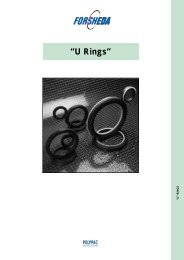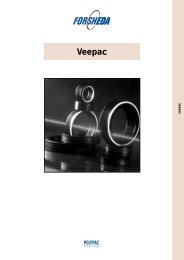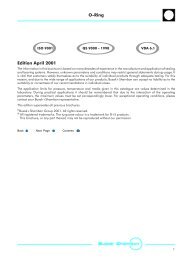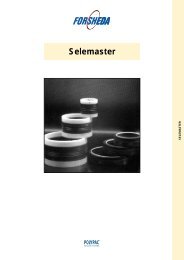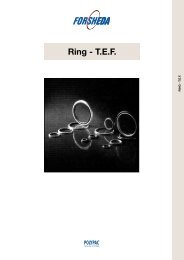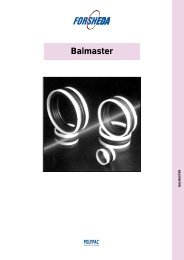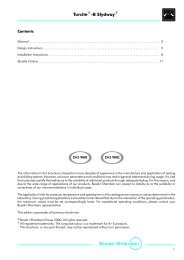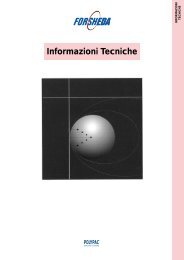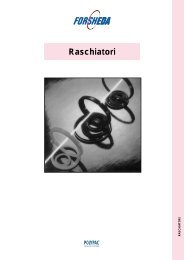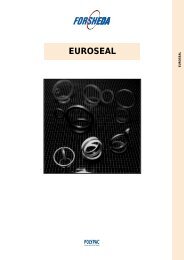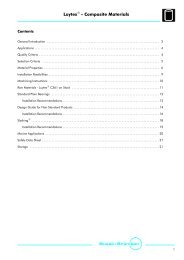Rotary Seals - Dilanda.it
Rotary Seals - Dilanda.it
Rotary Seals - Dilanda.it
Create successful ePaper yourself
Turn your PDF publications into a flip-book with our unique Google optimized e-Paper software.
Cassette Seal<br />
The counterface for the HRV seal can consist of a su<strong>it</strong>able<br />
surface on the existing hardware or a steel casing adapted<br />
to su<strong>it</strong> the specification for the seal counterface.<br />
The HRV seal:<br />
- seals against outer medium like dirt and dust<br />
- has a deflecting function due to the centrifugal force<br />
The requirements on the counterface against which the<br />
sealing lip works are rather low. The requirements are<br />
more or less determined by the medium to be sealed. A<br />
finish-turned, polished surface w<strong>it</strong>h a surface roughness of<br />
Ra 1.6 to 2.0 μm is normally adequate. For sealing against<br />
liquid and dirt, Ra 0.8 to 1.6 μm is recommended. However,<br />
the character of the surface is of greater importance than<br />
the actual surface roughness value. For turned surfaces, <strong>it</strong> is<br />
recommended to buff the surface w<strong>it</strong>h fine emery cloth to<br />
remove any sharp peaks, which could tear the rubber<br />
surface apart and destroy the sealing function and shorten<br />
seal life time.<br />
It is also necessary to ensure that the counterface is<br />
perpendicular to the shaft, flat and free from scratch<br />
marks and other damage w<strong>it</strong>hin the sealing area. This is<br />
especially important when sealing fluids and fine particles.<br />
To achieve the full effect of the deflector action, the HRV<br />
seal should be designed in a relatively open space.<br />
The f<strong>it</strong>ted width dimension will be stated on the<br />
corresponding product drawing.<br />
2,0<br />
F<strong>it</strong>ted width<br />
of HRV seal<br />
n Installation<br />
As the Cassette seal incorporate all functions as seal, shaft<br />
counterface and dust protection, there is no need for extra<br />
components as exchangeable shaft sleeves or dirt<br />
protection.<br />
This means fewer parts to stock and handle.<br />
When handling and f<strong>it</strong>ting trad<strong>it</strong>ional shaft seals there is<br />
always a risk for damaging the shaft surface or sealing lips<br />
and for improper installation. As the Cassette seal is fully<br />
enclosed the v<strong>it</strong>al sealing components cannot be touched<br />
or damaged during the installation.<br />
System 500 and System 3000<br />
When the bearing has been installed the seal is simply<br />
pressed into the hub bore. The seal shall be oriented w<strong>it</strong>h<br />
the side marked “oil side“ facing the interior of the hub. It<br />
is recommended to oil the inside rubber covered surface of<br />
the seal and also the shaft, to decrease the force necessary<br />
for assembly. If the Cassette seal is equipped w<strong>it</strong>h the<br />
add<strong>it</strong>ional dirt protection this shall be greased prior to<br />
f<strong>it</strong>ting. The complete hub is then entered over the axle<br />
spindle. Normally the locking nuts for the bearing are used<br />
to drive the hub home. The Cassette seal automatically<br />
takes the right pos<strong>it</strong>ion on the shaft and no axial support is<br />
required provided no over pressure will be built up during<br />
operation.<br />
During the start-up phase, some leakage of grease as well<br />
as smoke formation may occur. This is a result of the<br />
generation of frictional heat between the metal cases and<br />
support lugs, and does not influence the function and<br />
service life of the seal.<br />
If, on the other hand, the seal has been misaligned during<br />
installation, or jammed against the bore, this may lead to<br />
that the support lugs are in too close contact w<strong>it</strong>h the<br />
metal cases, and may be worn out or torn away at the<br />
start-up phase. The seal must in these cases always be<br />
replaced before start-up. When repairing of the wheel hub<br />
becomes necessary, a new seal shall always be installed.<br />
Figure 52<br />
System 500 w<strong>it</strong>h HRV seal<br />
142<br />
Latest information available at www.busakshamban.com<br />
Ed<strong>it</strong>ion April 2006



